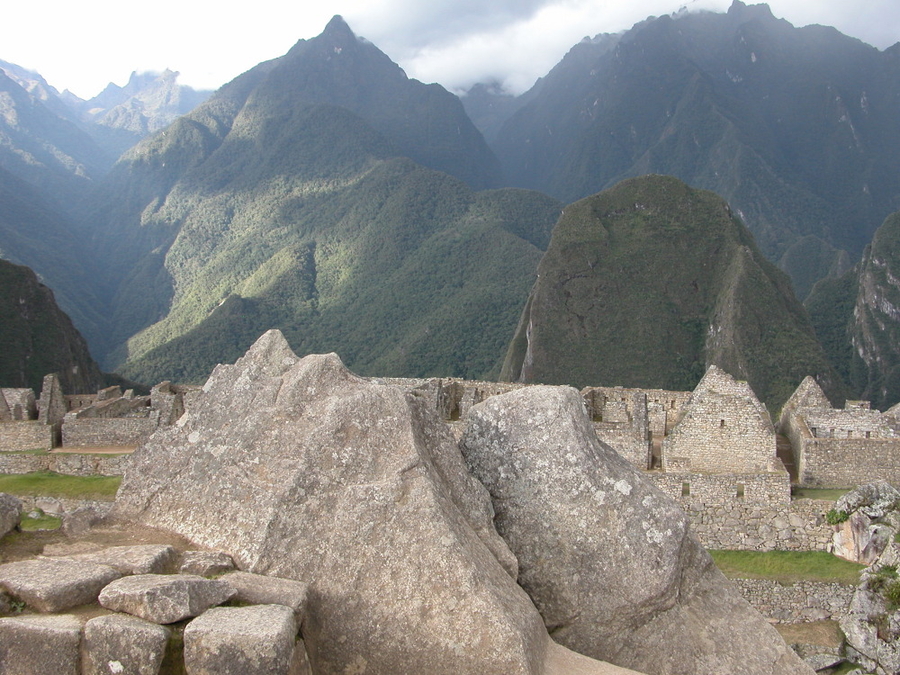The carved rock outcropping in the foreground of this photograph echoes the shape of the mountains beyond, directing the viewer’s vision out into the landscape while simultaneously bringing the power of a distant peak into the site at Machu Picchu, Peru. For the Inca, the landscape was both sacred and animate, full of forces that demanded respect and offerings. Distant mountain peaks, called apu—a term of respect meaning “lord”—were among the most powerful of these forces. They controlled the weather and closely watched the territories that they overlooked.1 While we may be interested in the way this rock looks like the mountains beyond (their mimetic resemblance), the Inca may have been more concerned with the way that carved rock and distant peak were both embodiments of the same powerful being, a relationship that Carolyn Dean terms “metonymy.”2
This rock is just one of several “echo stones” found at Machu Picchu, the winter palace of the ruler Pachacuti Inca Yupanqui, who governed an expanding Inca empire between 1438-1471 CE. When the frosts in the Inca capital of Cuzco grew too cold to bear, Pachacuti and his court moved to Machu Picchu’s lower and more temperate elevation.3 Located on the fertile slopes as the Andes Mountains descend towards the Amazon River basin, Machu Picchu was built on land that Pachacuti and his armies had recently overtaken, its construction a claim of dominion over newly-Inca territory. In this context, the “echo stones” established a relationship with the powers of the conquered land, demonstrating respect but perhaps also asserting control.
Carved stones and distant mountains were just two examples of the many kinds of things that the Inca termed huacas (also sometimes spelled wakas) or sacred things. Indeed, one seventeenth-century Spanish missionary lamented:
The things that these Indians worshipped were countless . . . they worshipped exceptionally large trees, roots, and other things that come from the land. . . . They also worshipped springs, rivers, lakes, and hills which were different in shape or substance from those nearby . . . the snow-capped mountain range and any other sierra or high peak . . . boulders or large rocks, cliffs and deep gorges, as well as the high places and hilltops . . . [and] an infinite variety of images and statues.4
While the Spanish were swift to destroy idolatrous images as they began their conquest of the Inca empire in 1532 and set about converting their new subjects to Christianity, these other indigenous conceptions of the sacred proved harder to recognize and eradicate. The Spanish were frequently stymied, for example, when Andean people continued to venerate the remains of a demolished “idol” even after the image was destroyed.5 Andean belief in the sacred landscape was especially difficult to root out. Even today, nearly five centuries after the destruction of the Inca empire, indigenous Andean people still make offerings and pilgrimages to powerful mountain peaks, and the echo stones at Machu Picchu still direct visitors’ eyes out to the sacred landscape beyond.
Notes
Notes
1. For modern ethnographic parallels see Catherine J. Allen, The Hold Life Has: Coca and Cultural Identity in an Andean Community (Washington and London: Smithsonian Institution Press, 1988), 40-44.
2. Carolyn Dean, "Metonymy in Inca art," in Presence: The inherence of the prototype within images and other objects, ed. Robert Maniura and Rupert Shepherd (Aldergate, England: Ashgate, 2006), 105-120; Carolyn Dean, A Culture of Stone: Inka Perspectives on Rock (Durham: Duke University Press, 2010), 41-44, 96-99.
3. For more about Machu Picchu see Richard Burger and Lucy Salazar, Machu Picchu: Unveiling the mystery of the Incas (New Haven: Yale University Press, 2004); Lucy Salazar and Richard Burger, "Lifestyles of the Rich and Famous: Luxury and Daily Life in the Households of Machu Picchu’s Elite," in Palaces of the Ancient New World, ed. Susan Toby Evans and Joanne Pillsbury, 325-57 (Cambridge: Harvard University Press, 2004).
4. Bernabe Cobo, Inca Religion & Customs, trans. Roland Hamilton (Austin: University of Texas Press, 1990), 44-45.
5. Tom Cummins, "A Tale of Two Cities: Cuzco, Lima, and the Construction of Colonial Representation," in Converging Cultures: Art and Identity in Spanish America, ed. Diana Fane, 157-69 (Brooklyn: Brooklyn Museum of Art, 1996), 160-162.
Keywords
Imprint
10.22332/con.obj.2014.10
1. Claudia Brittenham, "Carved rock outcropping, Machu Picchu," Object Narrative, in Conversations: An Online Journal of the Center for the Study of Material and Visual Cultures of Religion (2014), doi:10.22332/con.obj.2014.10
Brittenham, Claudia. "Carved rock outcropping, Machu Picchu." Object Narrative. In Conversations: An Online Journal of the Center for the Study of Material and Visual Cultures of Religion (2014). doi:10.22332/con.obj.2014.10



